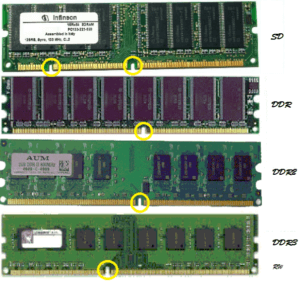RAM (random access memory) is the memory cache in which the operating system, programs, and data are kept so they can be quickly reached by the device’s processor. It is a major component of all modern computers and it can be used to gauge computer performance, along with the CPU, Hard Drive, and Graphics Card.
RAM serves as a memory storage device that is much faster to read from and write to than the hard drive. Data (strings of binary numbers) remains in RAM as long as the computer is running. When the computer is turned off, RAM loses its data. When the computer is turned on again, the operating system and other files are once again loaded into RAM, usually from an HDD.
An analogy can be made between a person’s short-term memory (RAM) and long-term memory (Hard Drive). Short-term memory focuses on the work at hand, but can only keep so many facts in view at one time. If short-term memory fills up, your brain is sometimes able to refresh it from facts stored in long-term memory. A computer also works this way. If RAM fills up, the processor needs to continually go to the hard disk to overlay old data in RAM with new, slowing the computer’s operation
Around the year 2000, double data rate random access memory (DDR RAM) was developed. And since, DDR RAM has undergone three evolutions, through DDR2, DDR3 and DDR4. Each iteration improved data throughput speeds and reduced power use. However, each version is not compatible with the previous ones, as data is handled in larger batches in each innovation.
When purchasing a PC or Laptop you will usually see a range of RAM options between 2 and 16 gigabytes. Depending on what type of computer user you are, what programs you plan on running on the computer, and how many programs you have open at a given time, the recommended amount of RAM varies. One of the best methods of determining how much RAM you should have is to look at the system requirements of the programs you’re running on your computer and double whatever the memory requirements are for the program you use most. But in general, we would recommend between 4-6 gigabytes of DDR3 RAM in order to run the most modern programs and operating systems.


No responses yet